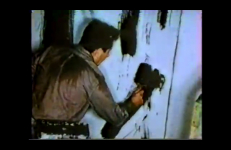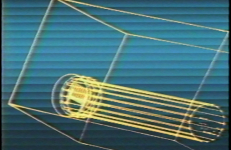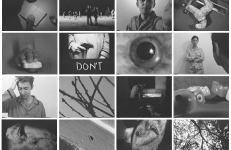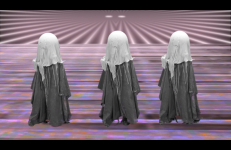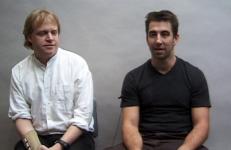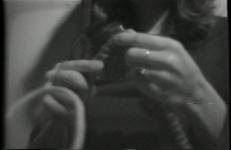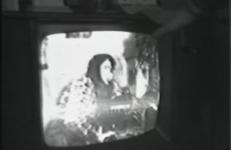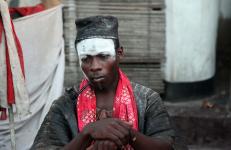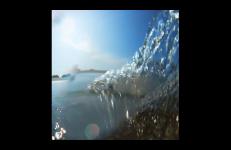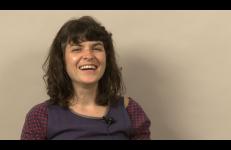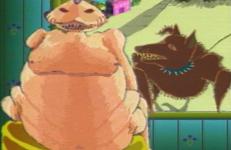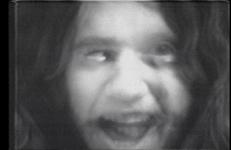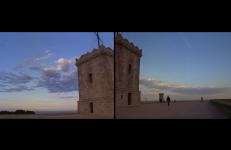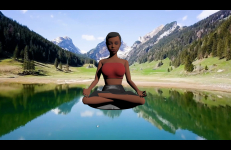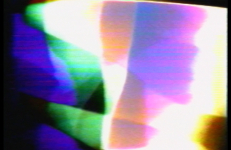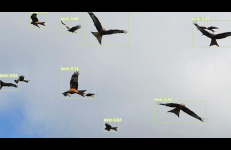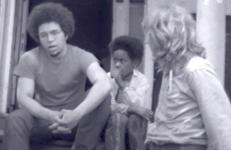In this interview, Brian Holmes, an influential art critic, activist and translator, discusses social forms of alienation, human ecologies of power, and the impact of technology on geopolitical social networks. Holmes reflects on his ongoing study of the ways in which the rhetoric of revolution has been institutionalized, as well as artists’ resistance to such cooption. For him, artists working in collectives have the potential to create a new artistic milieu that is not aligned with the dominant model of production. This argument is born out in his published collection of essays, Hieroglyphics of the Future (2003).
Technology
“Hey, how’s that TV work?”
Another dream film. Eschewing the hyperkineticism so beloved of Super 8 makers, I locked off my camera and wrote a slow narrative, combining live action and animation.
This video examines the iconic World Wide Web branding of the global marketplace, which creates disconnection and contrasts with the labor system in society.
Imagining future Deep Time, Post-extinction, using dark humor to speculate on the defiant vitality of matter to evolve life again. Two billion years from now, the oceans are beyond understanding. A soup of plastics, cloth and string, song and dance, collaborate to find new ways of moving in bleak time. The ghost of an oyster holds memories of what happened. It sings to a scrap of waste that fell to the bottom of the sea, trying to form new life, trying to get a face. With help from Stevie Wonder, undersea karaoke may still be possible.
The interstice of art and technology has proved to one of the most generative locations in contemporary transdisciplinarity. As media of all kinds become more electronically integrated and digitized across multiple platforms, current technologies approach a condition of complete imbrication with art practices, and vice versa. Ben Knapp and Andy Diaz Hope have been at the forefront of these techno-aesthetic interactions, and their career experience as hard-science engineers brings a level of practical competence to this interview that is truly enlightening.
Eerily drifting through soft fades, superimposed images, close-ups, and visual feedback, this tape follows less a narrative structure and more a stringing together of seemingly random activities, set against two very different soundtracks. The video opens with David Cort reclining on the ground as psychedelic rock plays in the background. Two shots alternate between frontal and profile as he lazily plays with his beard and face – the streams of footage melding together with the use of live editing.
This tape includes footage of one of the first broadcasts of Lanesville TV, as it appears on the television set of Lanesville local, Todd Benjamin, and a television set installed in a public bar. Interwoven with shots recording the program’s reception, are segments recorded for Lanesville TV itself: Bart (playing the part of “Russell”) approaches Parry, dressed as a hillbilly car mechanic “fixing” the VW Van; nearby, Nancy opens the door to a cabin, wearing a bonnet, while Carol and Chuck, crowding behind her, play the part of other Lanesville TV protagonists.
In Laser Games with Shirley Clarke, the Videofreex visit the apartment of independent filmmaker Shirley Clarke. Someone brings out a laser pointer, which they then use from the top of their building to shine on the sidewalks below in an attempt to distract the passersby. After returning indoors, they experiment with optical distortion by shooting the laser directly into the camera lens while listening to psychedelic raga music.
“To take back the gold that was stolen from us – this is the object of our actions.”
Lettres du Voyant is a documentary-fiction about spiritism and technology in contemporary Ghana, which attempts to uncover some truths about a mysterious practice called "Sakawa" — internet scams mixed with voodoo magic. Tracing back the scammers’ stories to the times of Ghanaian independence, the film proposes Sakawa as a form of anti-neocolonial resistance.
September 24th, 2016, North Avenue Beach, Chicago. It was a sunny day. According to the weather report, the temperature was 75°F, with the barometer reading of 30 inches height and the wind speed of 13 miles per hour. The time was 2:27 pm, I was standing by the Michigan Lake. In my hand there was a waterproof camera that weighs 2.6 ounces. I pressed the record button on the camera and threw it into the lake. The camera sank into the lake immediately and embarked on a mysterious journey. During the journey, it was elevated, pressed, panned, rotated, and spun by the water.
The Luminous Image was an international exhibition of video installations held in the fall of 1984 at the Stedelijk Museum in Amsterdam.
In this 2013 interview, experimental animator and School of the Art Institute of Chicago alumna Jodie Mack discusses the developments that have taken her from an interest in musical theater and playwriting to organizing microcinemas and DIY filmmaking.
Mack describes her interest in early cinema history and the relationship between its technologies and spectacle, particularly the manner in which video production incorporates planned obsolescence. Referring to the “scavenger nature” of her work, Mack discusses her interest in waste and her desire to use reclaimed materials in her work. Using fabric and paper to create shifting fields of color, Mack references corroded and glitched digital media in her work. Her use of quotidian materials reflects upon the role of abstract animation in everyday life, and serves to draw audience awareness to the spectacle of televisual technology.
– Kyle Riley
A post-apocalyptic computer animated vision of humanity lost in an industrial wasteland, Maxwell's Demon was animated on a low-cost, consumer computer model - an IBM PC. The tape takes its title from an early 20th-century physics theory postulating the existence of an impossible intelligence, a being that knew the exact location, energy, and direction of every particle in the entire universe - something akin to your home computer, but a lot bigger."
A wonderful and humorous example of early image processing, Parry Teasdale and Carol Vontobel perform to camera as their faces are morphed together, forming an image of one person.
Less than two minutes long, this short tape makes playful and surreal use of video’s editing capabilities. Set to a sped-up version of The Band’s “The Weight” – complete with the falsetto vocals, and accelerated tempo that come with time manipulation on records – is a series of rapid, alternating washes and split-image cuts overlaying and juxtaposing the faces of the freex upon one another. Male faces and female faces fuse, the exact identity of the individuals becoming dissolving into ambiguity.
Jacqueline Goss and Jenny Perlin retrace the journey of two 18th-century astronomers tasked with determining the true length of the meter. From the Mediterranean Sea to the English Channel, The Measures explores the metric system’s origins during the violence and upheavals of the French Revolution. Along the way, Goss and Perlin consider the intertwining of political and personal turmoil, the failures of standardization, and the subtleties of collaboration.
Jacqueline Goss and Jenny Perlin retrace the journey of two 18th-century astronomers tasked with determining the true length of the meter. From the Mediterranean Sea to the English Channel, The Measures explores the metric system’s origins during the violence and upheavals of the French Revolution. Along the way, Goss and Perlin consider the intertwining of political and personal turmoil, the failures of standardization, and the subtleties of collaboration.
Meditation is from Martine Syms’ Kita’s World series. Kita enacts the performances of everyday life in a hyper-digitized world. The character’s roles range from meditation guru to cultural commentator, and she speaks directly to questions of consciousness within the systems of labor, race, technology, and institutional failure. To the cognitive dissonance of Siri mishearing her speech, to the terror of (mis)representation, to the instinct to reconnect with nature.
Taped on Prince Street in Soho, New York City, Skip Blumberg creates a one-word performance. Shouting the word "money" over and over, he attracts the attention of New York's finest. The video crew attempt to explain to the policemen that there is no public disorder as the streets were empty when they began to tape.
The video is an unwitting early example of the reaction of the state to the use of video cameras on the streets.
The colorized abstractions of Moog Images were created by feeding Moog synthesizer oscillators into the video inputs of a television monitor. The oscillators were locked into the horizontal and vertical frequencies: thin lines of electronic “pencils” responsible for drawing the video image side-to-side and up and down. By slightly altering the frequencies of the oscillators, different images are formed. Thus, the images directly correlate to sound and are controlled by sound.
Intertwining associated experiments in image and sound generation using AI, Nearest Neighbor focuses on language acquisition and mimicry between humans, birds and machines, asking fundamental questions about consciousness, learning and understanding. The film is a contemporary reflection on the state of technology in relation to the natural world. It asks us to think about what we want from inter-species communication and what we expect from technologies that aspire to substitute for living beings.
Intertwining associated experiments in image and sound generation using AI, Nearest Neighbor focuses on language acquisition and mimicry between humans, birds and machines, asking fundamental questions about consciousness, learning and understanding. The film is a contemporary reflection on the state of technology in relation to the natural world. It asks us to think about what we want from inter-species communication and what we expect from technologies that aspire to substitute for living beings.
Skip Blumberg of the Videofreex conducts an interview with Charles “Cappy” Pinderhughes, the Lieutenant of Information of the New Haven branch of the Black Panther Party. From the steps of the New Haven headquarters, Cappy publicizes the upcoming Revolutionary Peoples Constitutional Convention set to take place in Washington, D.C. later that week (June 19th, 1970). In addition, Cappy provides a statement to be shared via the Videofreex at the Alternative Media Conference occurring at Godard College in Vermont.





